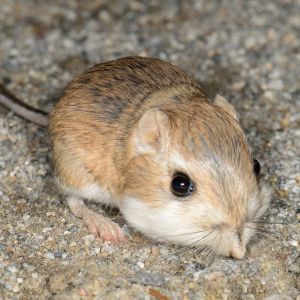SAN BERNARDINO KANGAROO RAT
Dipodomys merriami parvus
The San Bernardino Kangaroo Rat is primarily known from the Santa Ana River, Lytle and Cajon Creek and San Jacinto River. They are scarce primarily due to habitat loss and degradation.
Habitat consists of Riversidian alluvial fan sage scrub within alluvial floodplains. They prefer sandy substate on terraces above the low flow channel to protect them from inundation during storm events. They primarily eat seeds, which they collect in their cheek pouches and store in underground caches. Their need for water is satisfied by the seeds they consume. San Bernardino Kangaroo Rat breed from January to November and are active year around.

| Life Stage/Activity Period | Jan | Feb | Mar | Apr | May | Jun | Jul | Aug | Sep | Oct | Nov | Dec |
|---|---|---|---|---|---|---|---|---|---|---|---|---|
| Breeding |
See a map of the modeled species habitat distribution
Threats to this species include habitat loss and degradation, alteration of waterways, flood control, and dams which alter the natural hydrology and scouring needed to support this species. Management for the San Bernardino Kangaroo Rat includes vegetation management, water control to mimic natural processes and site protection to limit off-road vehicle disturbances.
How you can help: Try avoid using rodenticides and use live-traps or snap traps to remove unwanted mice and rats from your home.
